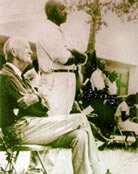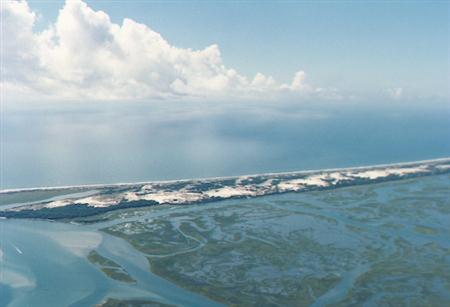SWANSBORO – A six-year legal wrangle over the fate of almost 300 acres of valuable waterfront property that could become part of Hammock Beach State Park is still no closer to being settled and may take several more months or even years to decide.
“This is a very complicated case,” said David Pearson, a local historian and the president of Friends of the Hammocks and Hammock Beach State Park. “Depending on the result of the (current) appeal, it could keep getting appealed.”
Supporter Spotlight
It’s also a convoluted tale that involves a beautiful piece of undeveloped property along Queens Creek that its original owner called a “peninsular wonderland.” It involves lawsuits and appeals that have twisted through two state courts. It’s peppered with heirs and descendants, charges and counter claims.
And it all began with an unusual friendship that defied Southern social norms of the time.
A Colorblind Friendship

Dr. William Sharpe and John Hurst |
Dr. William Sharpe, a wealthy neurosurgeon from New York, fell in love with the marshes of Onslow County during annual hunting and fishing trips in the early 1900s. He bought about 4,600 acres along Queens Creek known as The Hammocks in 1917 and hired his old guide and friend John L. Hurst and Hurst’s wife, Gertrude, to manage and live on the property. Sharpe’s Swansboro estate, which included the nearby barrier island Bear Island, would eventually grow to about 10,000 acres.
“John was the son of a slave, and his formal education in a backwoods school was meager, to say the most,” Sharpe wrote in his 1953 autobiography, Brain Surgeon. “Yet John can do anything in the rugged outdoor life, and do it well.”
Supporter Spotlight
Choosing the Hursts as caretakers, though, stirred quite a bit of local resentment. Anonymous letters were sent threatening trouble. Sharpe refused to be intimidated, though, and placed an ad in local newspapers offering a $5,000 reward for arrest and conviction of anyone damaging the The Hammocks or injuring the Hursts. “There was no further trouble,” Dr. Sharpe wrote.
Peace prevailed for the next 20 years, and Sharpe enjoyed and protected his paradise with frequent and lengthy visits. Controversy was once again ignited, in 1937, when North Carolina announced plans to build a road across Sharpe’s isolated property. His appeals to Raleigh brought no relief. Sharpe then sought the advice of a colleague, who also happened to be the personal physician of President Franklin Roosevelt. Sharpe had a three-minute meeting with Roosevelt. Within days, he wrote, “work on the road had ceased.”
A Resort for Blacks
Sharpe intended to give the property to the Hursts when he died. Gertrude Hurst, a former teacher, related what happened next in a newspaper article in 1979. “Dr. Sharpe offered the estate to me and my husband, and we’d have been glad to take it, but then he made another suggestion, because we wouldn’t have been able to do anything with it,” she says in the article. “He put the question before me, ‘How about turning it over to the teachers?’ knowing that there was an organization that would stick together, I guess. So, it just went like that.”
“In 1949 we transferred the acres constituting The Hammocks to the eight thousand Negro schoolteachers of North Carolina under an arrangement whereby we may share it with them so long as we live, as may John and Gertrude Hurst while they live,” Sharpe wrote in his book, “and we agreed to match every dollar they themselves raised for improving it. So vigorous and successful have they been in raising funds that it’s going to cost us a tidy sum of money, but nothing that we have ever done in our lives has given us more happiness.”The N.C. Teachers Association, an association for black teachers, created the Hammocks Beach Corp. to manage the land for the use and benefit of its members, effectively creating a segregated resort complex. Sharpe deeded the property to the corporation.
Black teachers and their families embraced the vacation spot during segregation. Following a successful fundraising campaign that raised $99,000, two group campsites were built and a third site was developed for use by individuals and families.
A second effort fell short to raise money for a bridge to Bear Island from the mainland. The corporation then donated the island and marshlands to the state in 1959, and Hammock Beach State Park opened two years later for blacks only. A few years later, the corporation sold another 30 acres on the mainland to the state for a park headquarters and ferry service to Bear Island.
Black teachers, students and families continued their vacations on the remaining mainland property to swim, fish, camp and enjoy the coastal landscape, just as Sharpe had imagined. But the crowds began to thin after 1964, when the federal Civil Rights Act ended racial segregation.
The Lawsuits Begin
Trouble began in the 1970s after the black and white teachers’ association merged to form the N.C. Association of Educators. After the merger, many black teachers no longer paid dues to the Hammocks Beach Corp. The lack of money coupled with the Sharpes’ and Hursts’ lifetime right to the land created problems.
“Sometime in the late 1970s there became some disagreement between the Sharpes, the Hursts and the Hammocks Beach Corporation,” according to Pearson. “Hammocks Beach Corporation filed a suit against the Sharpes and Hursts to ‘quiet the title’ to the property in 1986. They couldn’t sell or mortgage the property. As a result, there was an agreement referred to as the ‘consent judgment’ in October 1987.”

The Hammocks Beach Corp. gave Bear Island to the state in 1959 to be used as a state park for blacks. Photo: Sam Bland |
One result was that all the land, except for 289 acres, was divided between the Sharpe and Hurst families and eventually developed.
The Hammocks Beach Corp. controlled the remaining land. Members of the 4-H, Future Farmers of America and Boy Scouts were allowed to use the camps there.
John Henry Hurst and Harriett Hurst Turner, the grandchildren of John and Gertrude Hurst, filed a lawsuit in 2006 to remove the corporation as trustee of the deed, claiming it had failed to properly administer the trust.
The deed and an agreement between the Sharpes, the Hursts and the corporation provided that if it became impossible or impractical for the corporation to manage the property as originally planned, the corporation could transfer the property to the N.C. State Board of Education to manage as specified in the agreement. The deed further provided that if the board turned down the property, it would go to the heirs of the Sharpe and Hurst families.
On that the Hursts have hung their challenge. When seeking ownership of the remaining 289 acres, the Hurst’s lawyer, Charles Francis said the board had previously rejected the conveyance so the property should go to the heirs.
In a ruling handed down on Oct. 26, 2010, by Wake County Superior Court Judge Carl Fox, Hammocks Beach Corporation was removed as trustee, contingent on the formal appointment of the State Board of Education as successor trustee to administer the trust according to the 1950 deed. This time, the board of education chose to accept the appointment.
The Hursts have appealed that ruling to the state Court of Appeals, which also granted a stay while the appeal goes forward. Both sides have submitted briefs to the court, but no date has been scheduled for oral arguments.
According to Katie Cornetto, attorney for the state board of education, the board is defending the court’s decision to name it successor trustee for the property and if it becomes the trustee they would “seek to manage the property in accordance with the grantor’s wishes that it be maintained for the public for recreational and educational interests.”
That would presumably mean that the land would be added to the state park.
In the meantime, while the legal wheels turn slowly, the camping areas and meeting halls remain silent except for the peaceful sound of waves lapping the shore and the seagulls crying in the distance—disguising the turmoil that lies behind the future of the beautiful and tranquil property.







